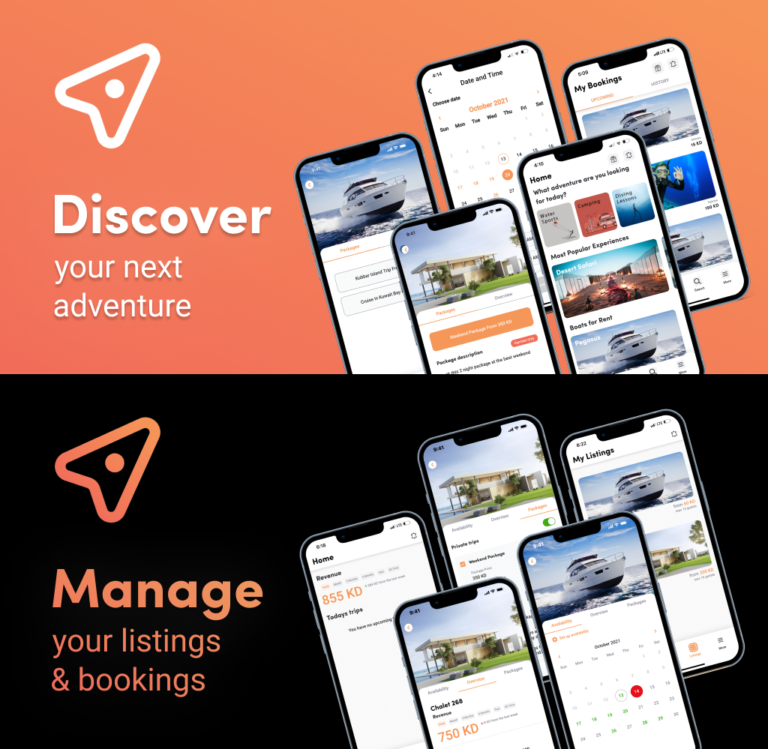Marketplace Mobile App: How to Build and Make It Reliable
The biggest retail giants in the world are marketplaces. Amazon, eBay, Etsy, Alibaba… these are just a few of them. These platforms help people sell and buy goods. They handle advertising and marketing and provide an audience for merchants and a big choice of products for buyers. How can you build a marketplace app and what should you watch out for? Find out in this article.
Why build a marketplace app?
Marketplaces have become the primary place for people to buy products. They’re beneficial for everyone: sellers, buyers, and marketplace owners. Thinking about marketplace app development, then this article will be useful for you.
Sellers enjoy having a place they can sell their products without having to put lots of effort into marketing. It’s way faster and easier to put your product on an online platform than to create your own eCommerce website or app and then struggle to get traffic, investing thousands of dollars in search engine optimization (SEO), app store optimization (ASO), and advertising.
It’s easier to sell a product on a marketplace because the target audience is already there.
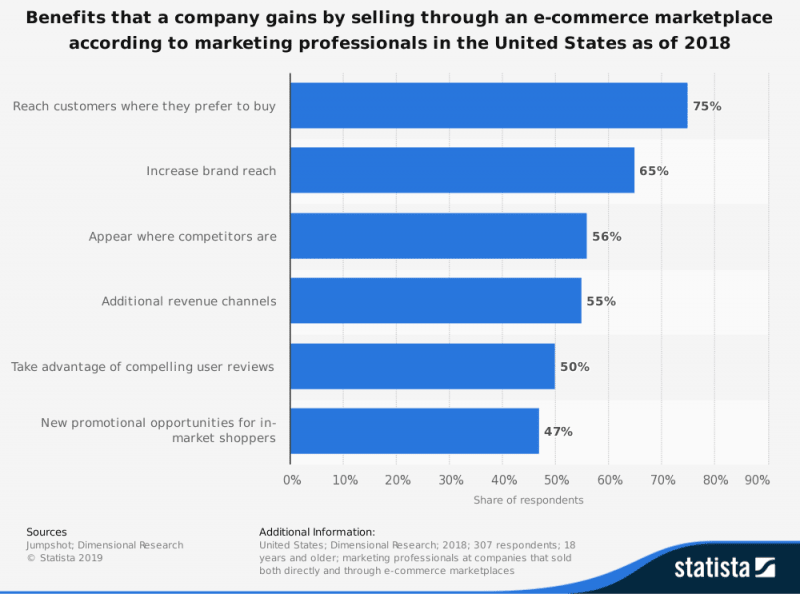
Buyers like to save time and money by buying products on marketplaces. They enjoy having lots of options for different prices and the ability to compare products and buy everything in one place without having to browse dozens of separate ecommerce shops.
You, as the owner of a marketplace, have lots of effective ways to generate revenue. You can get money from advertising, and of course, you can charge a percentage for each deal. Another business model involves seller subscriptions, which allow merchants to post a limited number of goods on their profiles.
Marketplaces are currently the most profitable form of online retail business.
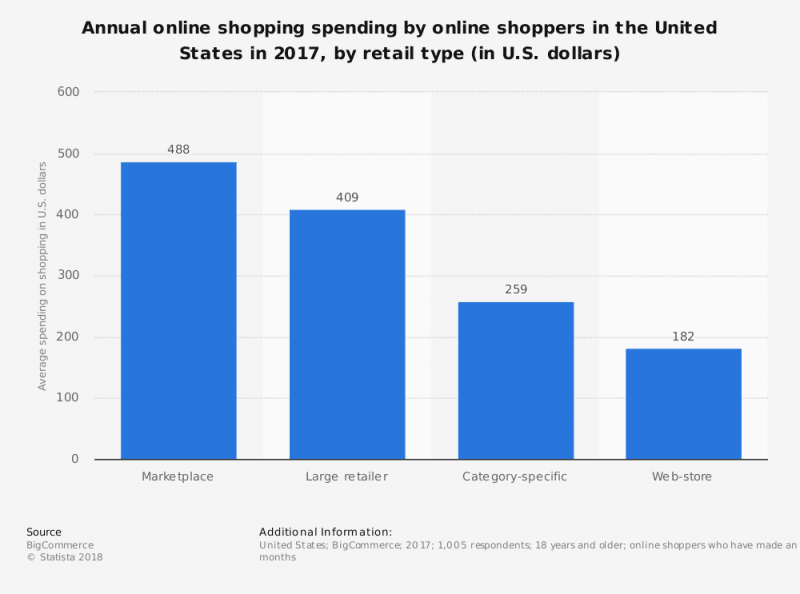
This type of online retail is especially popular in the United States, which means that other regions have lots of potentials.
To compete with existing marketplaces, you need to be mobile-first. For this business, having both a website and a mobile application is a must, as people make over 50% of their purchases via mobile phones. Mobile websites are also a great option, but they aren’t nearly as responsive and convenient as mobile applications.
If you don’t yet have a marketplace you’d like to expand to the mobile market, it’s a good idea to start from a website and deploy it as fast as possible
Another option is to use an app builder, but its templates won’t give you nearly as much versatility as you need to make your marketplace successful. An app builder is a good option for an MVP though, but after you find out what the market wants, you’ll need to create a custom app that will correspond to your business needs.

However, if you don’t yet have a marketplace you’d like to expand to the mobile market, it’s a good idea to start from a website and deploy it as fast as possible. A first simple version will give you the ability to test your service and make sure it has potential in the niche you’ve chosen.
Marketplace app development: key challenges & solutions
Building a marketplace is a lucrative idea, but like any business, it comes with both technical and business-related challenges. What do you need to prepare for? Let’s explore.
Fraud and chargebacks
Each marketplace attracts fraudsters that sell counterfeit products or straight-up deceive users by not sending the products that were paid for. Some buyers try to trick the marketplace as well by damaging goods themselves and then requesting chargebacks. Your marketplace should have clear rules for any aspect of the deal between a seller and a buyer, to avoid these issues.
To detect unreliable and fake sellers, use special fraud-detecting software or hire moderators that will check new listings and verify sellers’ identities.
Security
Security is a common issue for all types of software, and you should invest in it as well. A marketplace is a service that holds lots of sensitive information and handles the banking info too. Use secure payment gateways to avoid leaking the financial information of your users, and do regular security checks of your whole system.
Logistics
Logistics is a challenge for all e-commerce and delivery services. You need to offer multiple delivery options to your users, and make sure that each order reaches its destination in a predictable period of time. You should also deal with returns and replacements of the products. Partner with the local logistics services and use their APIs to track the packages and notify your users about the delivery status in real time.
Search
Search is the most important feature in a marketplace, and you absolutely need to get it right. Marketplaces connect thousands of sellers with thousands of buyers, so it’s easy for both parties to get lost in this ocean of products and services. There are two ways to approach this challenge:
- Centralized search. You narrow the options for buyers and sellers based on certain criteria like geolocation. This type of search is best for on-demand services like food delivery or taxi services, where you show only the sellers in a certain range away from a user.
- Decentralized search. You give your users all the tools like filters and categories, so they can narrow down the search themselves. If your platform has lots of similar products, implement recommendations, price comparisons, and other features to make the search process easier.
5 Types of marketplaces
Here are the 5 most common categories of online marketplaces:
- On-demand. This type of marketplace provides users with services that are in immediate demand by customers. For example, clothing rental, car rental, or home delivery of groceries.
- Managed. Managed marketplace always has an intermediary who intervenes to ensure the proper functioning of the marketplace. The intermediary provides support, logistical analysis, and maintenance.
- Community-driven. Community-driven marketplaces gather independent retailers and brands on its platform.
- SaaS. A SaaS marketplace allows users to build their own page within the marketplace network. However, it usually has sales commissions.
- Decentralized. In a decentralized marketplace, all power is in the hands of the sellers. There’s no operator to control the platform, it has a P2P system: anyone can enter to sell and buy.
What are the best marketplaces for ecommerce in 2023?
- Amazon is probably the most famous marketplace in the world. However, it is quite hard to stand out among thousands of items in the same category. Amazon charges high fees for sales – between 10% and 25% per sale.
- eBay is a marketplace with a bidding system at its core. It also has some fixed-price sales as well.
- Alibaba is Asia’s largest marketplace. Alibaba contains other marketplaces like AliExpress. Alibaba doesn’t charge any commission or hidden fees, but it benefits from commissions on other marketplaces in its group for marketing fees, for its Alipay payment system, and for membership.
- AliExpress is the most popular Asian marketplace today. It also operates in Europe and has physical stores in Spain.
- Etsy is the biggest community-driven marketplace for craft and vintage products. Its rates are USD 0.20 (20 cents) listing fee per product and a 3.5% to 5% transaction fee on top of the price.
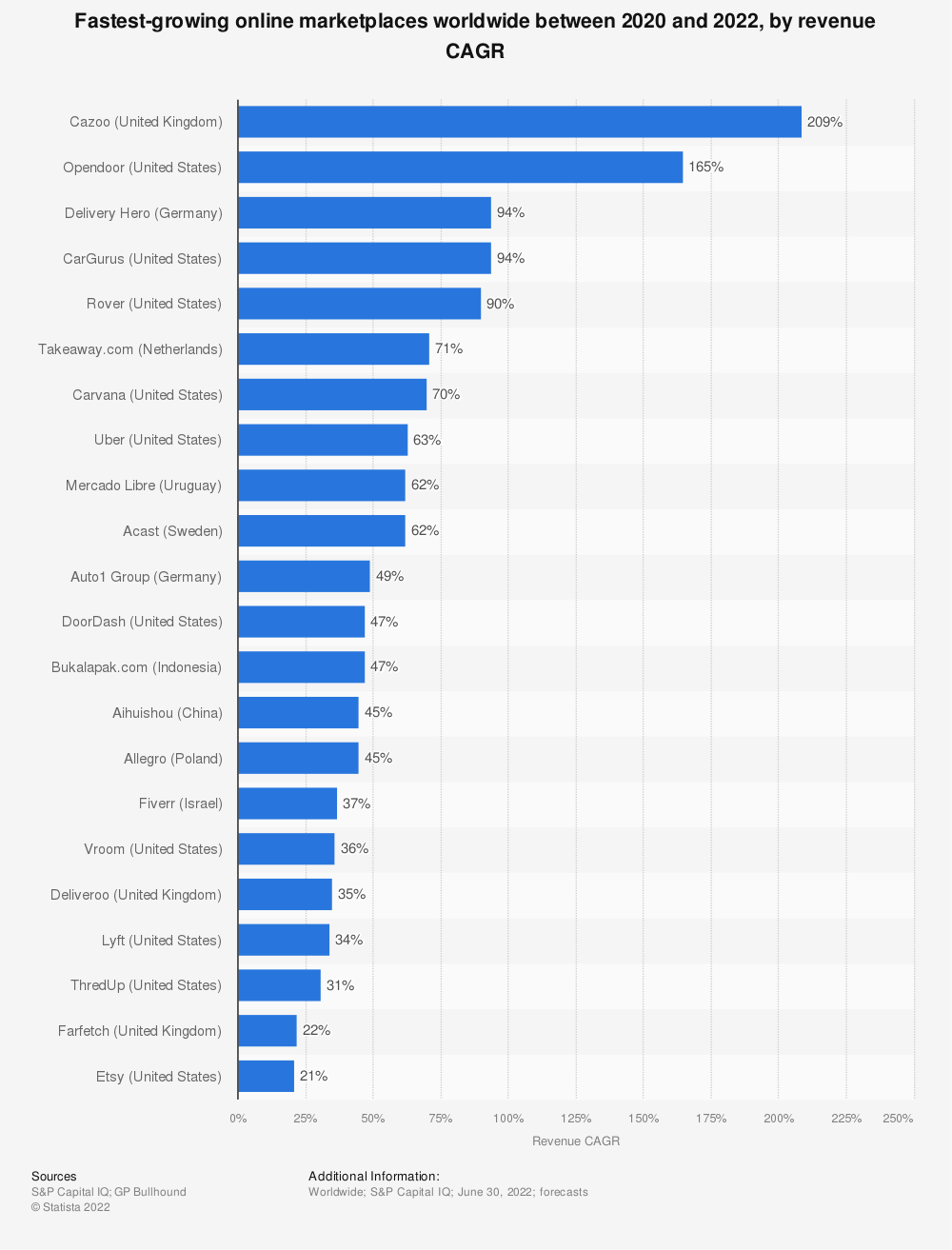
Now let’s find out what features are a must for the first version of your online marketplace application and what features you can add to make your app irresistible.
The perfect marketplace mobile app: Must-have features
Every marketplace involves several user roles, so you should take this into account when you create a marketplace app. These user roles are:
- Merchant
- Buyer
- Administrator
You can either combine seller and buyer roles into one application or make two separate apps. For administrators, you’ll need a separate web application, preferably for desktops.
Onboarding
The onboarding process should be easy and clear. You can let people sign up with emails or social media profiles.
The onboarding logic will depend on your app’s structure. If you have one app with two different user roles, allow people to choose to create a seller or a buyer profile.
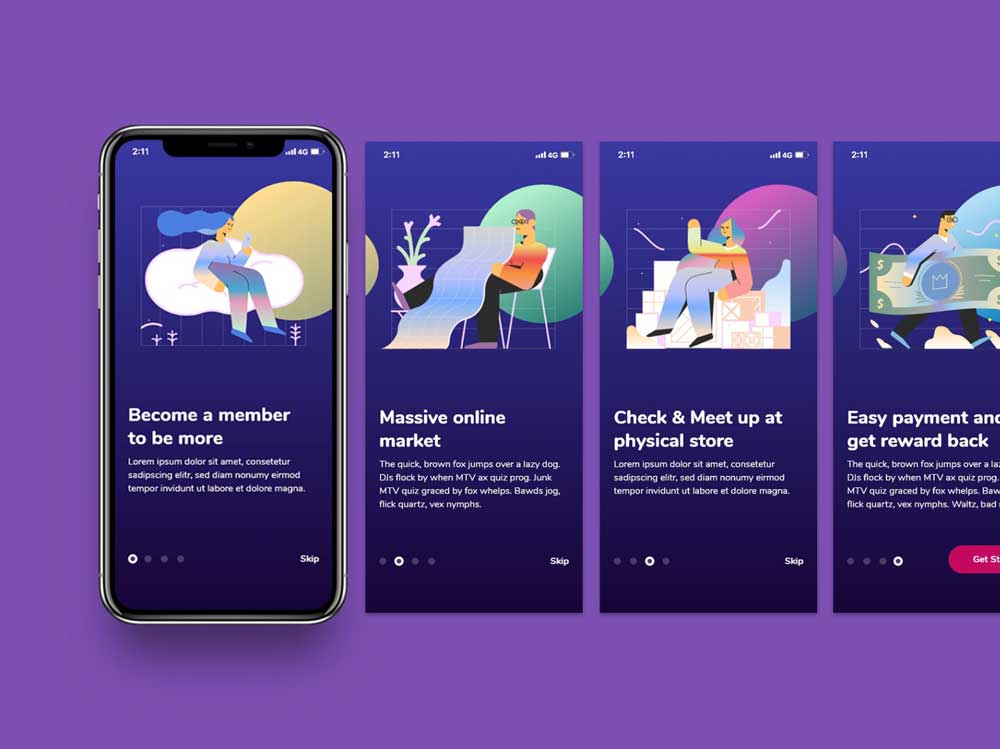
Another option is to combine these two roles in one profile so that a user can both buy and sell stuff through the same account. Or you can create two separate apps, but that’s rather uncommon for mobile marketplace apps.
Just after the onboarding stage you can add an interactive tutorial on how to use your app’s features and how to manage user profiles.
Personal profile
Users in both roles need to have personal profiles. A buyer’s profile should contain information about the user, their favorite items, current and past orders, a payment method (for example, a credit card), and settings.
Sellers should be able to see their own listings, the number of product views, and the number of people who have favorited one of their products. All users should see incoming messages and chat history. I’ll talk about these features more later.
Settings
There should be a short list of settings that allow a user to customize push notifications, personal information, and so on.
Listings
Listings are a core part of an application. They should showcase the products, including their names, pictures, and ratings. Pagination is crucial for listings: it allows the application to load information faster because it separates data into small chunks and loads it gradually.
Recommendations
If you want to drive sales in your application, you should not only showcase what’s available but make suggestions to users. You can base these suggestions on two things:
- Analysis of a large data set to determine what might be interesting to an individual user based on their previous searches and items they’ve added to favorites
- Products that were paid to be promoted on the main page of your app in the recommendation section
Categories
You should include categories in your mobile app for marketplace to make search more convenient for users. The categories will depend on what your marketplace is about. Be sure to make them logical.
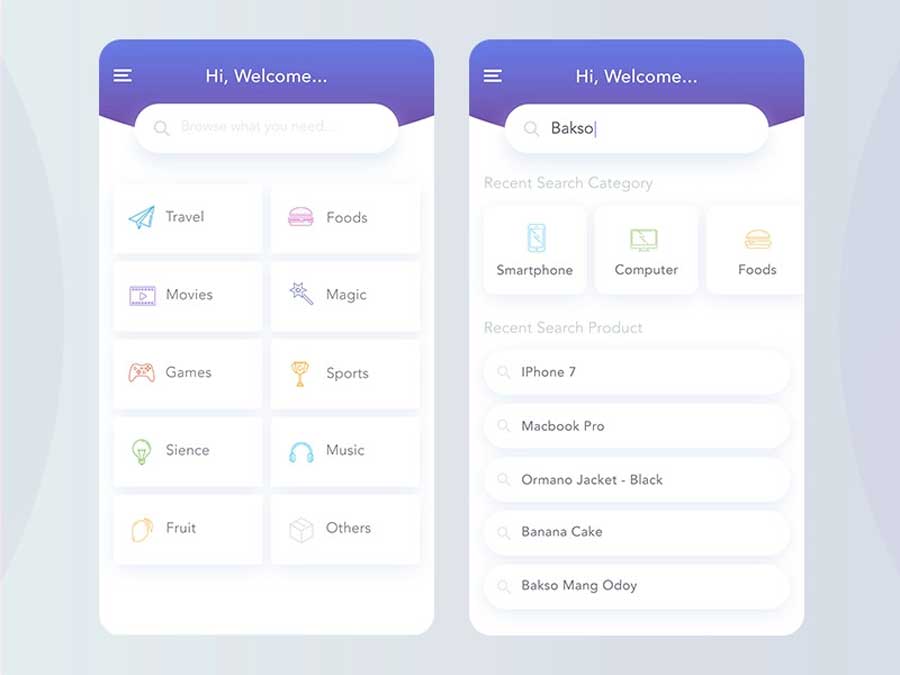
Search and filters
Search and advanced filters are crucial for a marketplace app. The best practice is to make search predictive. Aliexpress, for example, shows the number of results for a certain query, allowing a user to choose a query that will provide them with more options.
Filters by price, delivery type, rating, and so on are also an important part of any application that has anything to do with choosing products.
Product profiles
In product profiles, a buyer should be able to find all necessary information to make a purchase, including an item’s name, photos, a description, average rating, reviews, and characteristics.
Favorites
Allow users to add favorites so they don’t lose a product they like and are considering purchasing.
Ratings and reviews
Ratings and reviews are a must. Most people won’t even buy a product if there are no reviews, so this is a must-have feature. Ratings can come in lots of forms, but a five-star rating system is the most popular now. You can come up with something more original, but make sure the ratings are still clear for users.
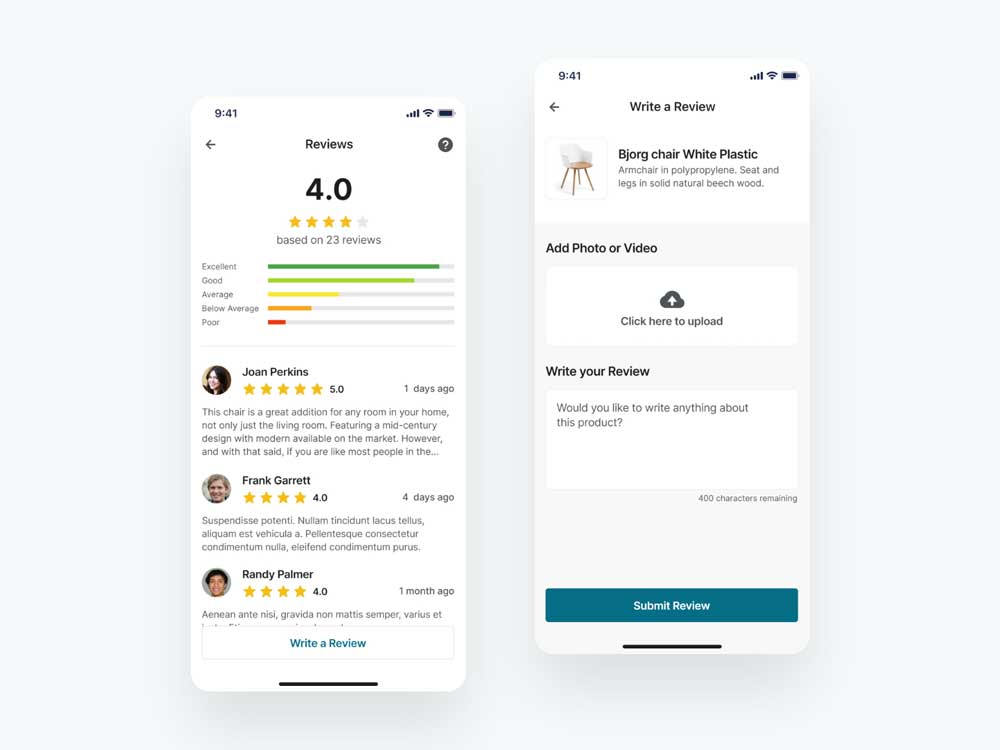
Shopping cart
A shopping cart is necessary for any retail mobile application or website. Allow users to add products from different sellers to their shopping cart and show the price of all products combined. Don’t forget to include coupons, discounts, and any other loyalty program attributes if you have them.
Payment gateway
Checking out is the next step a user will take after adding products to a shopping cart. To avoid shopping cart abandonment, make sure it’s fast and easy to pay. Don’t sacrifice security though, as it’s a primary concern for people who shop online. Be sure to choose a reliable payment gateway that will meet both your needs and your users’.
Delivery tracking
If you have a marketplace, delivery will probably be the responsibility of sellers. However, you should ensure that sellers send goods through a trusted delivery service. In any case, both buyers and sellers need to see the parcel delivery status in your application. This will make your service more trustworthy and convenient to use.
Order status and confirmation
Order status and confirmation helps sellers manage orders and see which can be considered closed. After a buyer confirms an order, they should be asked to leave a review.
Push notifications
Push notifications let your users know all about their orders, remind them of abandoned shopping carts, and inform them of any price changes or discounts. Rich push notifications are the best option for marketplace mobile apps because you can attach media to the notification. This makes it more visible and enticing to click on.
Analytics
Analytics is crucial for any application, and you should include it in your MVP prototype even if at first it seems useless. Analytics gives you an idea of how your business is doing, what parts of your strategy are working, and what isn’t performing as well as you expected. Analytics can help you find your niche and control your business development.
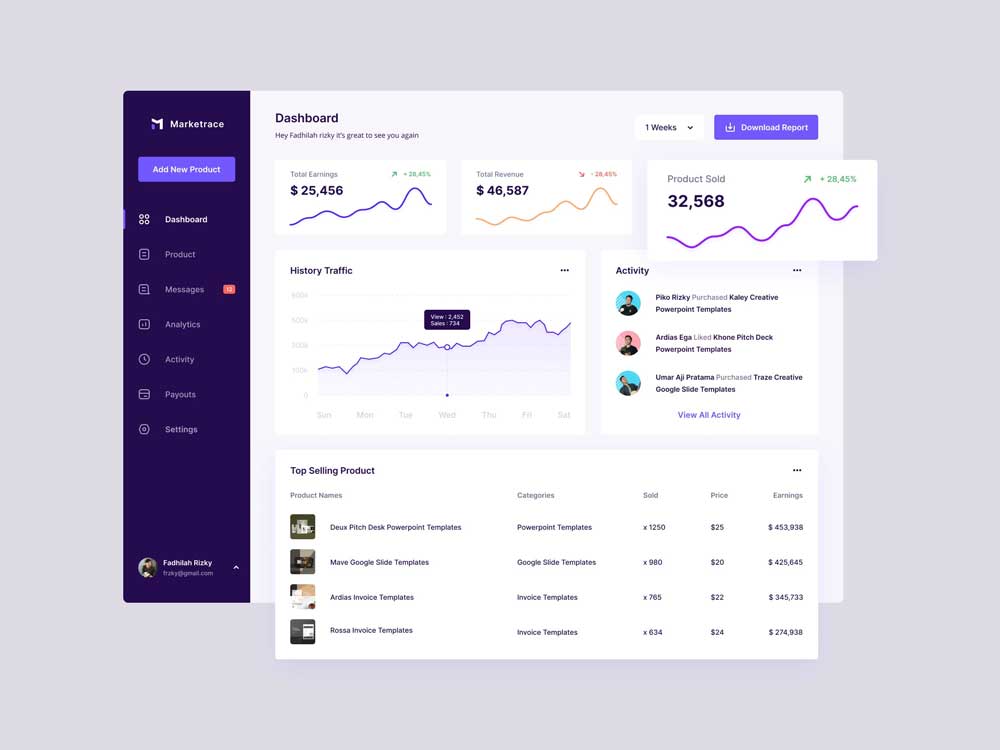
Profile statistics
Sellers on your platform should have access to statistics that give them an idea of how interested the audience is in their products. Minimal statistics should show product views and the number of people who have added a product to their favorites.
Product admin panel
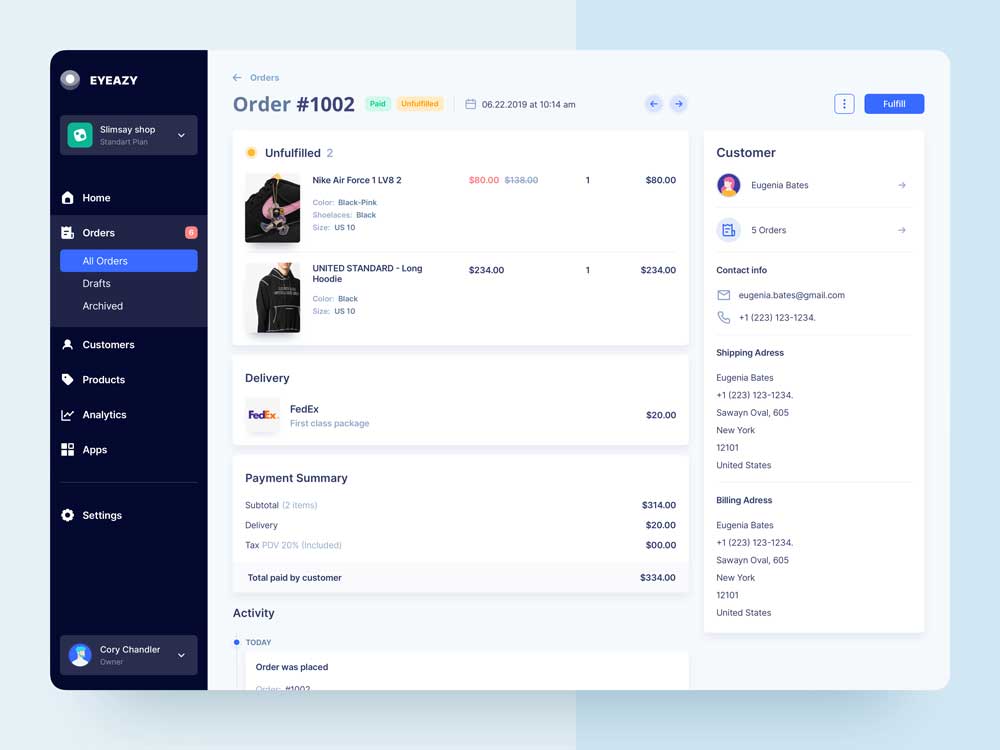
To manage a shop within your platform, a seller needs to add photos, descriptions, categories, and prices and edit all this information.
Support chat
A marketplace relies on trust. Your sellers need to trust you, and buyers need to be sure of your reliability as well. All users of your app must know that you’ll handle any dispute fairly. That’s why you need support in your application in some form. It can be text-based chat. Or it can be a callback button. But in our opinion, a chat is the best option because in a chat users can also attach screenshots and photos that prove their point. With this, your company will be able to solve issues faster.
A marketplace relies on trust. Your sellers need to trust you, and buyers need to be sure of your reliability as well
Strategy tips for marketplace startups
So, you’re building a brand new marketplace startup. How to go with it to increase the chances of success? How to build a marketplace app that stands strong among the larger competitors that already exist on the market? Here are a few tips.
- Choose your niche. In the world of Amazon, Etsy and other e-commerce giants, it’s really important to choose your niche. Think of the most narrow niche you can go for, and then make it even more narrow. This will allow you to attract an audience and find your place in the market. Surely, later in the game, you can expand, but at the very start, it’s more important to have an advantage over large platforms that offer it all.
- Focus on meeting your customers’ needs. Once you found your niche and your perfect customer, work very closely on meeting their demand. Your specific audience will have their specific needs and pain points, and here you need to use all your marketing efforts to speak your customer’s language and make your marketplace a go-to place to fulfill this one particular demand.
- Use creative marketing. The fight for attention is fierce, and larger marketplaces have millions of dollars to invest in marketing. That’s why you have to get creative and attract that organic traffic with unconventional, smart ways. Partner with micro-influencers, set up an SMM strategy, or take part in events that correlate with your narrow audience.
Technical approaches to marketplace app development
There are two main ways to approach the development of a marketplace: buying an off-the-shelf solution or investing in custom development. Let’s discuss both approaches, and their pros and cons.
Off-the-shelf marketplace solution
An off-the-shelf solution is a ready-made piece of software that is sold by its creator or distributor to multiple businesses. It usually has possibilities for customization and different payment methods. You can purchase a whole solution for a one-time payment and brand it as your own app, while also getting all the rights to its code. This is called a white-label solution.
An off-the-shelf solution will require regular monthly or annual payments. With that, you’ll also get support and maintenance.
Buying a ready solution sounds great because you don’t have to spend months on development. It’s also much cheaper. However, the customization abilities are often extremely limited, and you never know what’s under the hood, so the quality of a ready application is questionable at best.
Off-the-shelf solutions are great for testing your idea and hypotheses, but they don’t work as a long-term solution, because they aren’t scalable. Once your business starts growing, you’ll encounter more and more technical issues that are incompatible with adding new features, supporting a large user base, and offering excellent service.
Custom marketplace development
Custom development of a marketplace means building software from scratch according to your specific business needs, your target audience and market, and the functionality that’s required for you to deliver the best service possible. Custom development allows for endless customization possibilities, business experiments, new features, and a high level of scalability.
Custom marketplace development is costly, but it also offers opportunities for earning more through personalization, advanced notifications, recommendations based on user behavior, and so much more.
The quality of code and your app’s security is in your hands: you always know what’s happening inside your app, and have control over your software’s performance and reliability, which is important for the business’s success as well.
The tech stack for a marketplace
There are lots of technologies you can use to build a marketplace application. It requires several separate software products: a buyer app, a seller app, a backend part, and an admin panel for your moderators and administrators.
You can build a single app for sellers and buyers, just add two different profiles with different functionalities. In most cases, you’ll also need a web version of your marketplace so that users can access it from their desktop computers or mobile browsers. Let’s discuss the technologies for each part of this infrastructure.
Frontend technologies
Developers use HTML5, CSS, and JavaScript libraries (Angular, Vue, React) to develop the front end of marketplace websites.
Backend technologies
The most popular programming languages used for server-side development include PHP, Ruby, Java, and Python.
Operating systems
Selecting an operating system (OS) is the first decision you need to make. There are four major operating systems today:
Web server
The two main open-source and free web servers are Apache and Nginx.
Databases
Databases are a vital part of the server ecosystem that allow multiple data points to be maintained and processed. The most popular databases are:
- MySQL
- MongoDB
- DynamoDB by Amazon
- Firebase by Google
- PostgreSQL
Storage
The most popular storage solutions are:
- Amazon Simple Storage Solution (AWS S3)
- Firebase Storage by Google
Programming languages
These are the main programming languages used in website technology stacks, with associated frameworks in brackets.
- PHP [Laravel]
- Java [Spring]
- Python [Django, Pylons, Flask]
- Scala [Play]
Mobile technologies
For a mobile app, you can choose either native or cross-platform development. Native frameworks like Java and Kotlin (for Android) or Swift and Objective-C (for iOS) are perfect for large applications with complex business logic. They can use all the possibilities of a platform and devices, but you need to develop separate apps for each platform.
Cross-platform technologies on the other hand are less advanced, but you need only one app to be present on both Android and iOS devices. Out of all cross-platform technologies, I’d recommend Flutter, as it boasts great performance and easy maintenance.
Third-party services
Oftentimes, a marketplace website needs additional tools to meet business needs. To do this, developers integrate third-party services into the code of an online store. The most popular integrations include:
- Payment gateways
- Analytics tools
- Shipping modules
- CRMs
- Social networks
- Multi-vendor stores such as eBay and Amazon
Integrations such as accepting alternative payment methods can make your customer service more convenient and increase your conversion rates. Here are some of the payment systems you can integrate:
- Stripe
- Authorize.Net
- PayPal
- Braintree
Analytics tools display important business metrics like the conversion rate, customer lifetime value (CLV), bounce rate, and cart abandonment rate. Examples of analytics tools:
- KISSmetrics
- Piwik
- Hotjar
- Woopra
Delivery modules are important for online stores, as they inform customers about shipping costs and the delivery time of their orders. Here are some examples:
- ShippingEasy
- Shippo
- Sellbrite
- ShipStation
Integrating a CRM is also popular, especially if the online store has a lot of customers. A customer relationship management system helps online store managers collect customer data such as names, email addresses, phone numbers, and purchase histories. This integration is useful when analyzing customer behavior based on previous purchases.
The most popular CRM integrations among our customers are:
- Salesforce
- Zoho
- InfoFlo
- Microsoft Dynamics
The cost of marketplace app development
The marketplace app development cost depends on:
- Your scope
- Technologies and tools
- Third-party services
- Hourly rate of the development company
The hourly rate depends on the country where the marketplace app development company is situated. For example, an application that may cost over $150,000 in the US may cost only $25,000 in Ukraine.
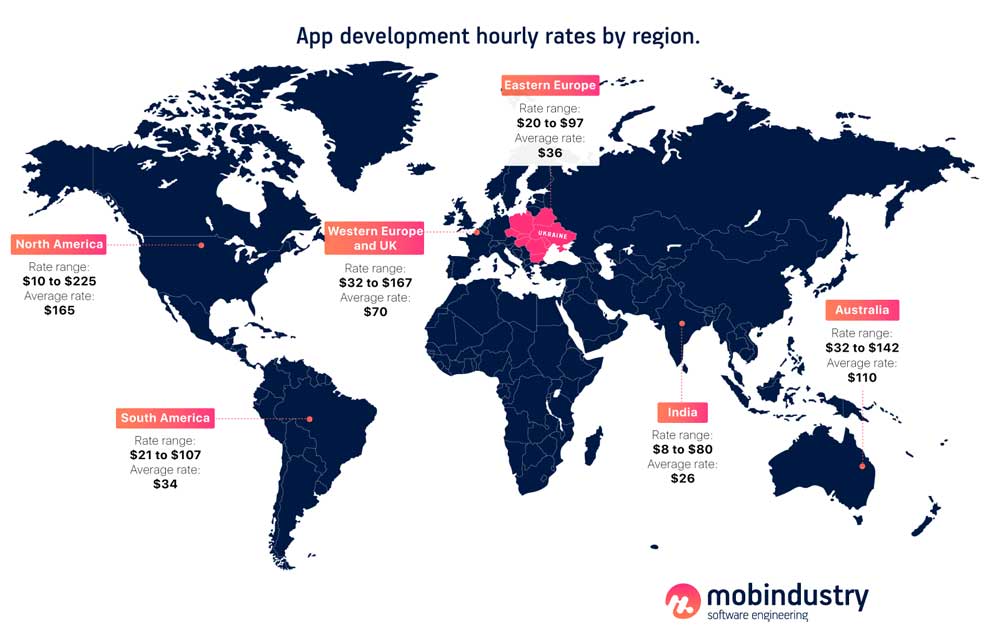
Here you can see the costs of all the features I mentioned in this article. You can choose the ones you’ll need for your marketplace app and see approximately how much your app might cost.
| Feature | Estimate in days |
| Onboarding | 3 – 5 |
| Customer personal profile | 2 – 5 |
| Seller personal profile | 2 – 5 |
| Tutorial | 1 – 2 |
| Chat | 2 – 4 |
| Settings | 2 – 3 |
| Listings | 3 – 6 |
| Recommendations | 2 – 4 |
| Categories | 2 – 3 |
| Search | 2 – 6 |
| Filters | 2 – 3 |
| Push notifications | 2 – 4 |
| Product profiles | 2 – 4 |
| Favorites | 1 – 2 |
| Ratings and reviews | 2 – 4 |
| Mobile payments | 2 – 3 |
| Analytics | 6 – 14 |
| Shopping cart | 2 – 4 |
| Delivery tracking | 1 – 2 |
| Support chat | 3 – 5 |
If you want to develop two marketplace apps for Android and iOS, you’ll need to multiply your budget by 1.75.
Note that this is only the cost of developing a set of features. The whole marketplace app development process consists of lots of other things you’ll need to consider in your budget. Let’s look at the main steps of marketplace mobile app development.
Main steps of marketplace mobile app development
1. Creating a technical specification
If you don’t have a technical specification, you’ll need some time to communicate with a business analyst who will then create one for your app. This will help make sure the final result matches your expectations and will give you a clear idea of the budget you’ll need for the whole app.
2. Design
If the design of your app is complex, design can take up to 20% of the whole development time.
3. Creating a development environment
Before starting development, programmers need to set up the system, create architecture, and prepare all the necessary APIs.
4. Development
The cost of development includes the cost of quality assurance services, which is compulsory at Mobindustry. We don’t provide clients with code that wasn’t checked, so at least a minimum of quality assurance will be included in the development process. Note that you’ll also need to spend time on communication, as it’s very important to be on the same page with your team and get reports about everything that happens on the project.
To keep people using your app, you need to take care of it and update it when new libraries and operating systems come out
5. Deployment and optimization
The final step of building a marketplace app is deploying it to the app store. To let people know about it, you’ll need to optimize your profile for the app store’s search engine.
6. Maintenance and support
To keep people using your app, you need to take care of it and update it when new libraries and operating systems come out. Maintenance is an important part of any application’s life cycle, and the better you support your app, the longer it will be relevant.
Conclusion
A marketplace application is a big project that requires lots of attention before, during, and after the main development process. Before creating a marketplace app, decide on all the details: how you’ll monetize your platform, what products or services it will feature, and how you’ll make sure people trust you.
If you already have a marketplace website, don’t just recreate it on mobile
After that, contact an experienced development team that can help you formalize your idea and translate it into a technical specification. This document will be a guide for developers and an assurance for you, as you’ll know exactly what you’ll get at the end of the development process.
If you already have a marketplace website, don’t just recreate it on mobile. Make sure to add mobile-specific features and build a marketplace mobile app that will bring value for your mobile users. You can add gamification and even augmented reality to get way ahead of your competitors.
Now, you have an idea of how to build a marketplace app.
To find out more about the budget you’ll need to develop a marketplace app, contact us through the form below. If you’re shortlisting mobile development companies for creating your own marketplace, you might as well add Mobindustry to your list. To find out more about our company and how we work with our clients, check this article.
Frequently Asked Questions
The marketplace app development cost depends on:
- Your scope
- Technologies and tools
- Third-party services
- Hourly rate of the development company
The hourly rate depends on the country where the marketplace app development company is situated. For example, an application that may cost over $150,000 in the US may cost only $25,000 in Ukraine.
- Amazon
- eBay
- Alibaba
- AliExpress
- Etsy


